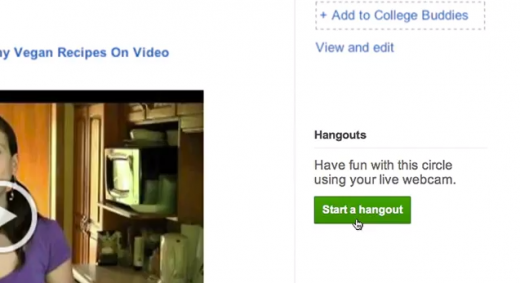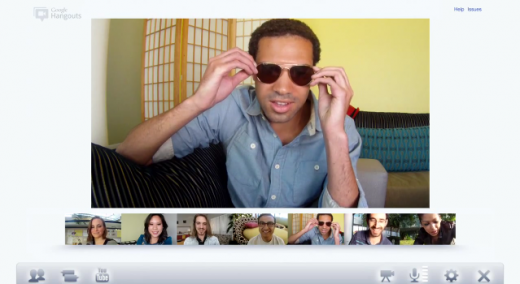
Google’s social network, called Google+, is growing in terms of users and interaction, serving as the search giant’s competitor against its more established rivals in Facebook and Twitter.
Whilst the service draws many parallels with Facebook, one of Google+’s standout features is Hangouts; a video chat room that allows any Google user to connect from YouTube, Gmail, iGoogle and Orkut (and other Google properties) and chat to their friends, hold meetings or meet people for the first time using their webcam and a microphone.
The service supports up to 10 people chatting at any one time.
Many believe Google introduced the feature to compete with Skype, the popular app-based VOIP voice calling software, using the hook that it did not require additional clients and could be initiated in both the browser and via the official Google+ mobile app with the click of a button.
Whether the feature was a direct response to Skype, we may never know, but the story behind how Hangouts came to launch on Google+ is an interesting one.
For example, did you know that Hangouts took a little over an hour to be prototyped and was rolled out internally within the same day?
This information came courtesy of Google Engineering Director Chee Chew, who took the time to explain the development of the Google Hangouts feature in a recent (you guessed it) Hangout on Dan McDermott’s Google Plus Week online show.
From idea to prototype
During the Hangout, McDermott asked Chew whether the idea for Google Hangouts came from Google co-founder Sergey Brin. Whilst Brin was certainly involved in the process — by putting “some gas behind it” — Google Hangouts originally started with the idea that Google Talk should be rolled out onto the social network.
Chew was running Google Talk at the time and in a meeting with Brin and Google’s SVP of Engineering Vic Gundotra, they asked him to put chat within Google+. Chew had another idea:
“We already had this thing that was a permanent video network between Kirkland (a suburb of Seattle) and Stockholm. We were partners, but we had a hard time communicating with each other so we set up a permanent link and that link was called the Hangout.
I tried to describe this to Sergey and Vic, and they kind of got it. So I opened my laptop and joined the Hangout and there were people from Kirkland and Stockholm and then all of a sudden there was Sergey and Vic. So we hung out and chatted really quickly and they asked me how long it would take for me to prototype it.
So I said, it would take about and hour. We already had the code and it was just a matter of gluing it together, so Sergey said ‘Go ahead and do it, do it right now.'”
Incorporating Hangouts into Google+
Chew was meant to be taking a flight from Google HQ in Mountain View to Seattle three hours after his meeting with Brin and Gundotra, so before he left, he was “dragged over to a developer” and was instructed to tell him how to implement his Hangout code into the platform.
“We sat down for fifteen minutes,” Chew said, “He wrote the code and and I told him how to construct the link and then I took off to the airport.
I called in from Seattle Airport, just to check on how things were going, to see if things were okay and whether they needed help. Whilst I was in-flight, that developer had finished the code, pushed the servers and deployed it internally.
Vic was already in a hangout and he pinged me as soon as I logged in. So, I joined it and there was a Hangout with like 15 people in there. Vic shouted ‘Weeee! We have Hangouts!’ and that’s how it started.”
The original Hangout service was similar to how it looks now, it had thumbnails and a main screen but it was not nearly as polished but it was very unstable. At the time it was a work in progress.
It turns out that the Hangouts team was the very last team to join Google+, so initially people within the team didn’t understand the purpose of the tool and how it operated. Chew and his partner worried over early feedback, which labelled it as a basic video-conferencing service, but as the it rolled out publicly, the unease was dispelled as Google+ users took to it and started hosting their own Hangouts with the simple click of a button.
You can see Dan McDermott’s Hangout, complete with Chew’s history of the service, embedded below:
The Hangout, today
Google has continued to evolve the Hangouts service, adding new features and holding live events with many high-profile figures, including President Obama, the Dalai Lama and Desmond Tutu.
The service was the first piece of Google’s social layer to have a proper API, which until recently was been in “preview” mode. The Google+ team announced that not only will the Hangouts API come out of preview, it has added a new Apps section in Hangouts to support the creation of developers:
One of the most important ways we connect with others is in person. That’s why we’re so excited about Google+ Hangouts, and why we launched a preview of the Hangouts API a few months ago. Today we’re moving this API out of preview, and enabling developers to launch and share their hangout apps with the entire Google+ community!
Hangout apps are regular web apps, running in a big window inside the Hangout UI. In addition to using shared-state APIs to give users real-time interactivity, you also have access to built-in Hangout features.
The company will be highlighting some of the best apps available for Hangouts, which include a poker game called “Aces Hangout”:
The Apps section will also feature all of the effects that Google+ has been building internally, such as adding an overlay onto your video, turning you into a cat or dog. It’s clear that Google feels like it has hit a sweet spot with Hangouts, as most of the newest releases within Google+ have had to do with the feature.
For example, Hangouts recently got Google Voice and Docs integration, which appeal to business users. These new apps will appeal to regular consumers who want to chat with friends or family over video. By allowing you to do more while having a video chat, Hangouts certainly appear to offer more options than Skype or FaceTime at this point.
Get the TNW newsletter
Get the most important tech news in your inbox each week.







